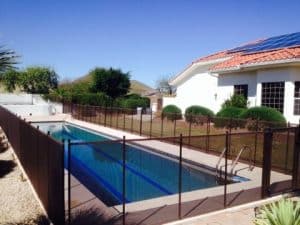At Pool Safety Fencing, we understand that budgeting for a pool fence project is a crucial aspect of ensuring the safety of your loved ones. In this article, we’ll discuss the cost considerations involved in planning your pool fence project, helping you make an informed decision that aligns with both your budget and safety requirements.
Contents
1. Material Selection
The choice of material significantly impacts the cost of your pool fence. Here are some common materials and their associated costs:
- Mesh: Mesh pool fences are typically among the most cost-effective options. They offer a balance between safety and affordability.
- Aluminum: Aluminum pool fences are durable and moderately priced. Their elegant appearance adds value to your outdoor space.
- Wood: Wooden pool fences vary in cost depending on the type of wood and design. They can be cost-effective or more expensive, depending on your preferences.
- Glass: Glass pool fences are on the higher end of the cost spectrum due to the materials used and their luxurious appearance.
- Vinyl: Vinyl fences fall in the mid-range in terms of cost. They offer durability and require minimal maintenance.
2. Fence Height and Length
The dimensions of your pool area will impact the overall cost. Taller fences and longer perimeters will naturally require more materials and labor, increasing the project’s cost.
3. Design and Customization
Customization options, such as ornamental elements, decorative posts, or unique colors, can add to the cost of your pool fence. These design choices allow you to personalize the fence to match your outdoor aesthetics.
4. Installation
Professional installation ensures that your pool fence meets safety standards. While DIY installation might seem cost-effective initially, it can lead to issues that may be more costly to rectify in the long run. Hiring experts ensures a secure and compliant installation.
5. Gate(s)
The number and type of gates in your pool fence will also impact the overall cost. Self-closing and self-latching gates are essential for safety and may add to the project cost.
6. Local Regulations
Compliance with local safety regulations is non-negotiable. Be prepared to budget for any necessary permits, inspections, or modifications required to meet local pool safety codes.
7. Maintenance
Consider ongoing maintenance costs when budgeting for your pool fence. Some materials, like wood, may require more maintenance over time, while others, like aluminum or vinyl, are relatively low-maintenance.
8. Long-Term Value
While initial costs are important, it’s also essential to consider the long-term value of your investment. A well-constructed and durable pool fence can add value to your property and provide peace of mind for years to come.
Conclusion
Budgeting for your pool fence project requires careful consideration of materials, dimensions, customization, installation, and ongoing maintenance. At Pool Safety Fencing, we’re here to assist you in making informed decisions that prioritize both safety and your budget.
For expert guidance on budgeting for your pool fence project or to request a quote, contact us at 480-771-8026 or visit our website here. We’ll work with you to ensure that your pool area is safe without breaking the bank.
Invest in the safety of your loved ones while staying within your budget. Trust Pool Safety Fencing to provide cost-effective solutions that don’t compromise on safety.




